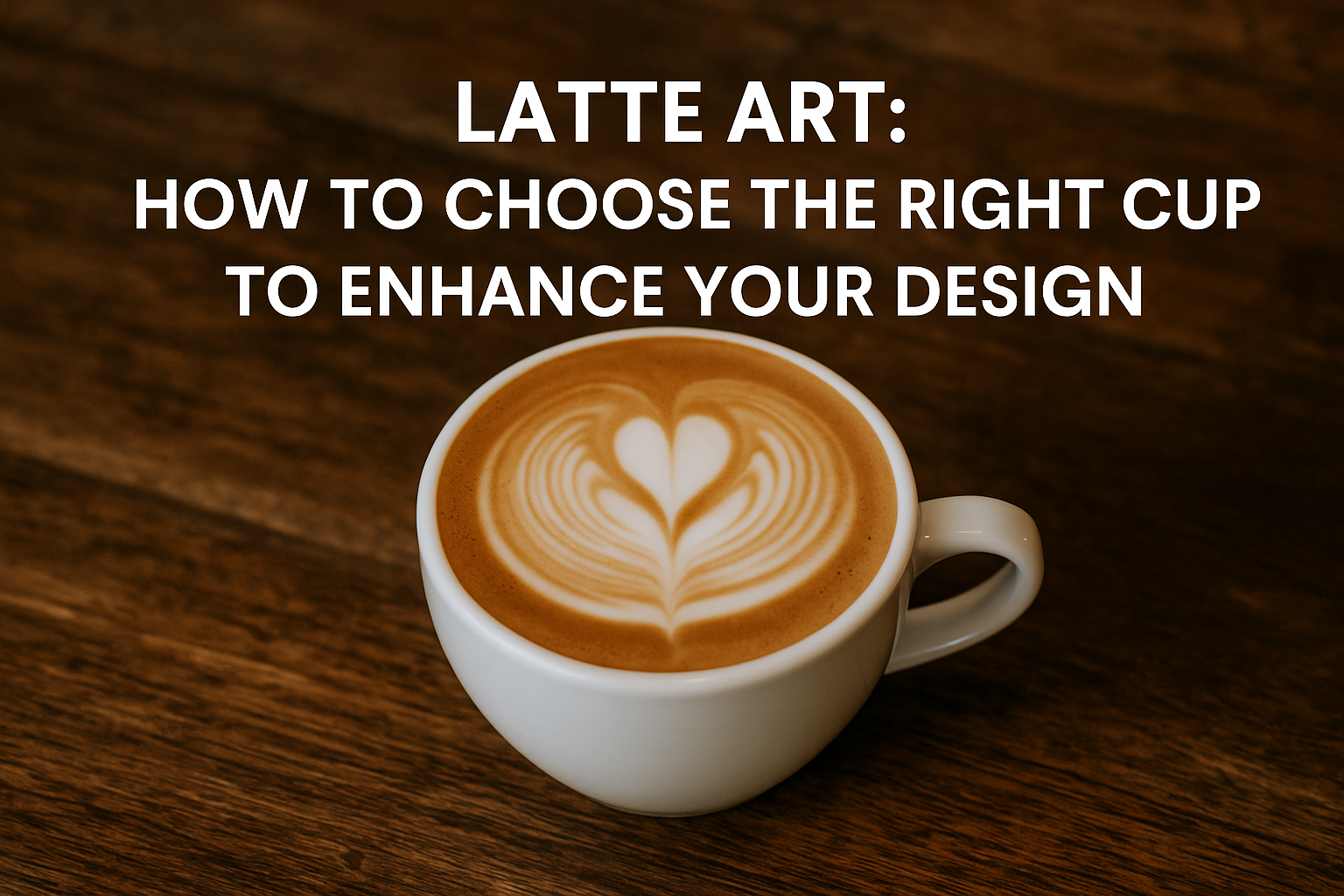Latte art is not just about the milk and espresso — it’s also about the canvas. And in this case, your canvas is the cup.
While many people focus on technique, few realize how much the shape, size, and material of a cup can influence the clarity, balance, and final impact of your design.
Choosing the right cup can make your latte art easier to pour, more visually appealing, and even improve the overall drinking experience.
Let’s explore the essential elements of cup selection and how each factor affects the quality of your latte art.
Why the Cup Matters
Latte art is a visual art form created through fluid motion. The cup acts as the foundation — the space where milk and espresso meet. A poorly chosen cup can:
- Limit your pouring space
- Distort the design’s shape
- Disrupt milk flow
- Hide details under the rim
On the other hand, the right cup enhances your control and presentation, making each pour smoother and more consistent.
The Ideal Size for Latte Art
The most commonly recommended size for latte art is between 5 to 8 ounces (150 to 240 ml). This size range is ideal for a standard cappuccino or flat white and gives you enough room to create distinct shapes without overcrowding.
Smaller Cups (3–5 oz)
- Often used for cortados or macchiatos
- Very limited surface area for detailed art
- Requires high precision
- Better suited for single-pour designs like hearts
Medium Cups (6–8 oz)
- Perfect balance between milk and espresso
- Enough surface for complex patterns like tulips and rosettas
- Easier for beginners to manage flow and symmetry
Larger Cups (10–12 oz and up)
- Common for lattes in cafés
- More space for elaborate designs
- Requires more milk and more control
- Can make contrast weaker if milk is too diluted
If you’re just starting out, go with a 6 to 8 oz cup. It gives you the best mix of control, visibility, and milk-to-espresso ratio.
Shape: The Most Critical Factor
The shape of the cup impacts how milk flows across the surface, how foam settles, and how easy it is to build layers in your design.
Rounded Bottom
This is the gold standard for latte art. A rounded bottom allows milk to circulate naturally as it’s poured, making it easier to stack shapes and control flow.
It also helps the crema stay intact longer, improving contrast.
Flat Bottom
Flat-bottom cups make milk movement more abrupt, causing designs to break apart. They’re harder for beginners to manage.
However, skilled baristas can still produce clean art with the right technique.
Tapered or Conical Shape
Some cups are narrower at the bottom and wider at the top. This shape can work well if the inside remains rounded. The flared opening also showcases the design better from above.
Be cautious with steep tapers, as they can restrict milk flow and impact control.
Thickness of the Rim
The rim of the cup affects both pouring and drinking experience. A thick rim may trap foam and distort fine lines. A thinner rim provides a smoother entry for milk and gives a cleaner look to the design.
Choose a cup with:
- Thin or medium rim
- Smooth curve from base to rim
- Even thickness for heat retention and comfort
Avoid cups with overly thick edges, especially if you focus on detailed art like swans or layered tulips.
Material: More Than Just Style
The material of your cup affects heat retention, texture, and even how light reflects off your design. Here are common materials used in latte art cups:
Porcelain
- Most popular for professional use
- Excellent heat retention
- Smooth surface for easy pouring
- Durable and dishwasher safe
Porcelain cups are standard in most specialty coffee shops. They provide the best combination of function and aesthetics.
Ceramic
- Similar to porcelain, slightly heavier
- Holds heat well
- Comes in many styles and colors
A good option for home baristas who want durability with a bit more personality.
Glass
- Allows visual appreciation from all angles
- Poor heat retention
- Slippery surface for pouring
Glass cups look beautiful but are not ideal for practicing latte art. Use them for display, not for training.
Stainless Steel
- Durable and nearly unbreakable
- Maintains temperature longer
- Not visually ideal for latte art display
Steel cups are practical but don’t offer the aesthetic payoff most latte art enthusiasts look for.
Handle Position and Grip
It may sound minor, but the handle of your cup plays a subtle yet important role. A well-placed handle helps you:
- Tilt the cup correctly while pouring
- Maintain hand comfort during slow, controlled pours
- Avoid accidental shaking or misalignment
Look for a handle that fits your fingers without requiring too much tension. Your pour hand should move, not struggle.
Color: Enhancing Contrast
White or light-colored cups help make the contrast in your latte art more visible. Designs like rosettas or hearts stand out more clearly against a bright background.
Dark or patterned cups may hide details or make the milk look dull, especially if your espresso’s crema is light.
When practicing, always use plain white cups so you can better evaluate your progress.
Weight and Balance
A heavy cup offers stability, but too much weight can strain your wrist. Lighter cups are easier to handle but may shift during pouring.
Aim for a balanced cup that feels secure in your hand. Try pouring with a few different options to find what suits your personal pouring style.
Cup Brands Preferred by Baristas
Some brands are favored for their build quality and pour-friendly design. If you’re shopping for cups, here are some names to look for:
- NotNeutral: Known for ergonomic shapes and specialty design
- Loveramics: Popular in competitions, excellent balance and style
- Acme Cups: Wide range, great for both home and café settings
- Aidea: Affordable and effective for beginner training
Most of these are available in various sizes and colors. Prioritize cups that are latte art certified or barista-designed.
Choosing the Right Cup for the Design You Want
Different latte art patterns require different space and milk flow. Here’s a quick guide:
Hearts
- Can be made in almost any cup
- Works well in small or medium sizes
- Needs controlled, direct pour
Rosettas
- Better in rounded cups
- Medium size gives the best leaf definition
- Requires room for consistent flow
Tulips
- Needs space to layer pours
- Best in 6–8 oz cups
- Wide opening helps build shape
Swans or Advanced Art
- Needs maximum control and wide surface
- Go for 8–12 oz with flared top
- Perfect for showcasing artistic skill
Choose the cup based on the style you practice most.
Common Mistakes in Cup Selection
Avoiding the wrong cup is just as important as choosing the right one. Here are some mistakes to steer clear of:
- Using cups with straight or flat bottoms
- Ignoring rim shape and thickness
- Practicing in colored or patterned cups
- Using large mugs with too much milk
- Skipping the test pour before service
Try pouring into your cups with water before steaming milk. It helps you feel the grip, tilt, and space in advance.
Training with Multiple Cups
If you’re serious about improving your latte art, don’t limit yourself to one cup. Practice with a few different types to develop adaptability.
Set up a session where you pour the same design into 3 different cups. Note how each one changes the flow and look of the pattern.
Over time, this training improves your versatility and prepares you for real café service where you might not always get your favorite cup.
Final Thoughts: The Cup Completes the Craft
Latte art starts with espresso and milk, but it ends in the cup. Choosing the right cup can elevate your design, enhance your workflow, and even make your coffee more enjoyable to drink.
For consistent, beautiful latte art, focus not only on technique — but also on the tools. A well-designed cup is more than just a container. It’s a key part of your creative process.
Start with a good 6–8 oz porcelain cup with a round bottom and thin rim. From there, build your skills and experiment with new styles and shapes.
When your cup complements your pour, magic happens.

Marcelo Rodrigues is a passionate barista with over 7 years of experience in specialty coffee. He’s worked in top cafés, led barista training sessions, and now shares practical tips to help beginners and coffee lovers improve their skills. Through this blog, Marcel makes the world of coffee more accessible—one cup at a time.

